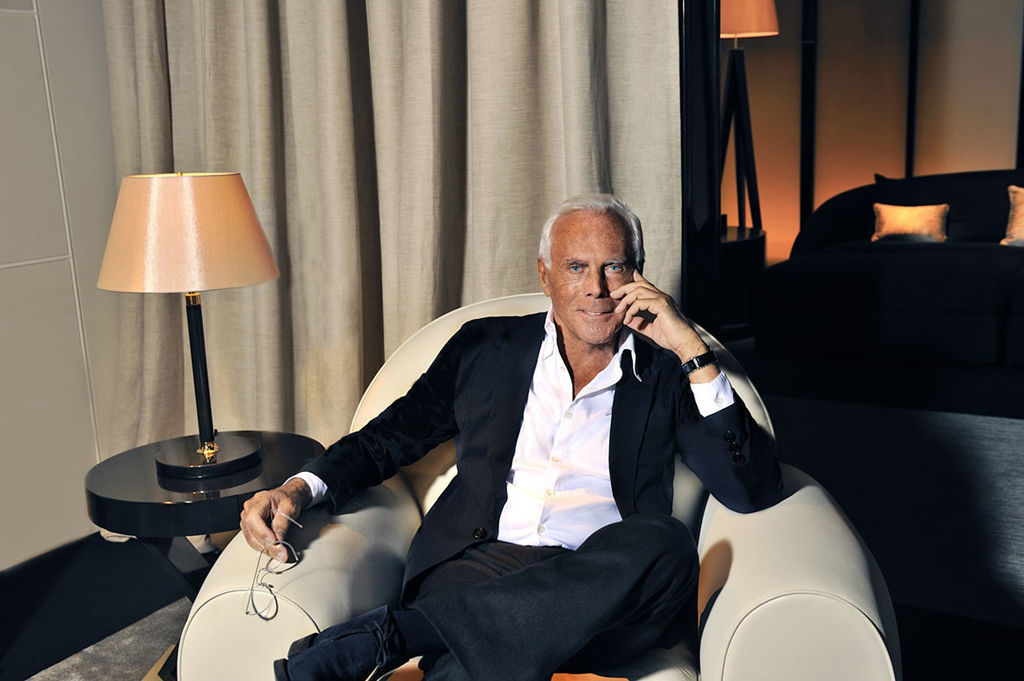“… Their driver was a strikingly handsome man in a tailored Armani suit. He looked more like a movie star than a skipper, but this was, after all, Venice, the land of Italian elegance.”
This passage describes the moment in which Robert Langdon, traveling with his friends from Santa Lucia station to St. Mark’s square in Venice, expresses all his knowledge and respect for one of the biggest brand of the italian fashion industry: Giorgio Armani.
Giorgio Armani is an Italian fashion designer, particularly noted for his menswear.
He formed his company, Armani, in 1975, and by 2001 was acclaimed as the most successful designer to come out of Italy.
The Italian fashion house Armani designs, manufactures, distributes, and retails haute couture, ready-to-wear, leather goods, shoes, watches, jewelry, accessories, eyewear, cosmetics, and home interiors.
Early years
Armani was born 11 July, 1934 in the town of Piacenza, where he was raised with his older brother Sergio and his younger sister Rosanna by his mother Maria Raimondi and father Ugo Armani, a shipping manager.
Since he intended to become a doctor, he enrolled in the Department of Medicine at the University of Milan. However, in 1953, he broke off his studies and joined the army. Because of his medical studies, he was promoted and transferred to an infirmary in Verona. After experiencing hospital life and occasional evenings at the Arena in Verona, he decided to pursue a different career in fashion.
Design career
He started working as a window dresser at La Rinascente, a department store in Milan. Then, in 1957, he went on to become a salesman for the menswear department, gaining valuable experience on the marketing side of the fashion industry. After a seven-year stint in that position, he decided to pursue a career in fashion design, training in the atelier of Nino Cerruti, where he designed menswear.
In 1975, with the help of his friend and business partner Sergio Galeotti, an architectural draftsman, he founded Giorgio Armani S.p.A. in Milan, presenting in October his first collection of ready-to-wear for men and women.
Armani established an innovative relationship with the fashion industry, characterized by the 1978 agreement with Gruppo Finanzario Tessile (GFT), which allowed him to produce luxury ready-to-wear under the attentive supervision of the company’s designer.
In 1979, after founding the Giorgio Armani Corporation, Armani began producing for the United States and introduced the Main line for men and women. The label became one of the leading names in international fashion with the introduction of several new product lines, including G. A. Le Collezioni, Giorgio Armani Underwear and Swimwear, and Giorgio Armani Accessories.
In the early 1980s, the company signed an important agreement with L’Oréal to create perfumes and introduced Armani Junior, Armani Jeans, and the lower-priced diffusion line Emporio Armani, followed in 1982 by the introduction of Emporio Underwear, Swimwear, and Accessories.
Throughout the 80s, Armani felt that he had to make use of new and unconventional advertising methods, which included television spots, enormous street ads, and a house magazine sent out by mail to consumers.
He also felt that a relationship with the cinema was essential, both for promotional reasons and for the stimulus to creativity. He therefore designed the costumes for American Gigolo (1980), in which actor Richard Gere was featured as the dashing owner of a closetful of tailored Armani clothing.
This success led him to a long-term collaboration with the world of film, for which he designed costumes for more than one hundred films, one of the most important of which was The Untouchables (1987).
After Galeotti’s death (1985), Armani continued to expand commercial horizons and licensing agreements. He opened Armani Japan and introduced a line of eyeglasses (1988), socks (1987), a gift collection (1989), and a new “basic” men’s and women’s line for America known as A/X Armani Exchange (1991).
Over the years Armani continued to add new offerings to his company, introducing new lines of cosmetics and home furnishings, and expanding its line of accessories.
In 2000-01 the Guggenheim Museum in New York presented a major retrospective of Armani’s work, a first for a living designer to highlight his celebrity in the fashion world.
Picture byhttp://www.arca-lab.com






![Composition, 1955. Di Willem de Kooning [Da Kandinsky a Pollock, Palazzo Strozzi]](https://www.florenceinferno.com/wp-content/uploads/2016/04/pollock-80x60.jpg)

